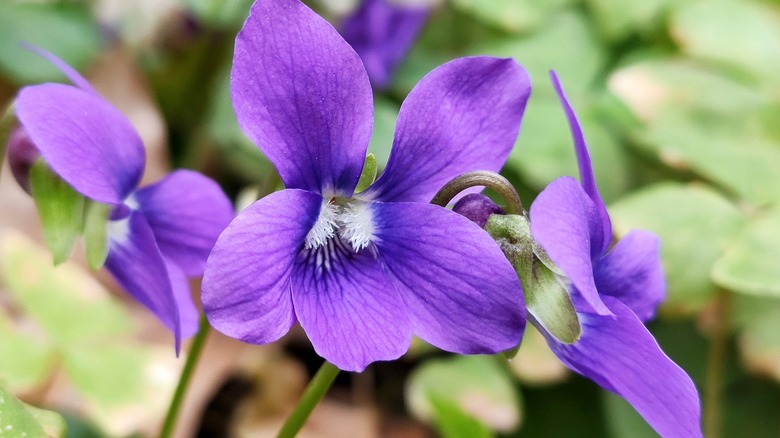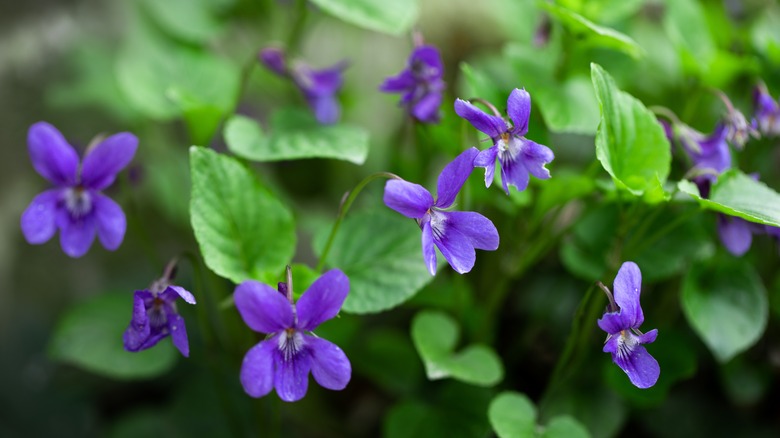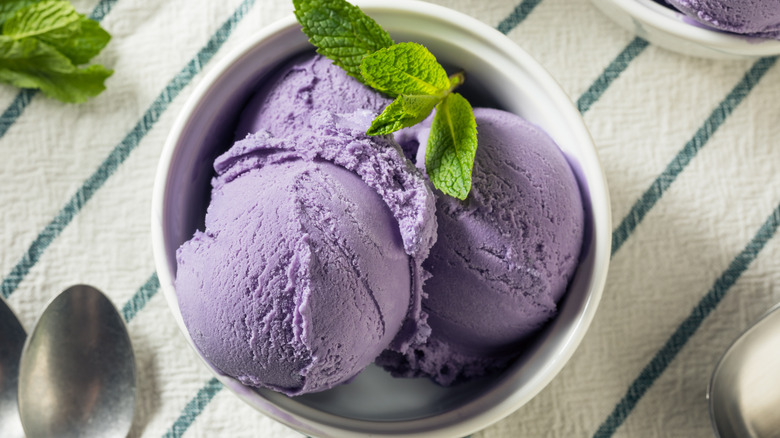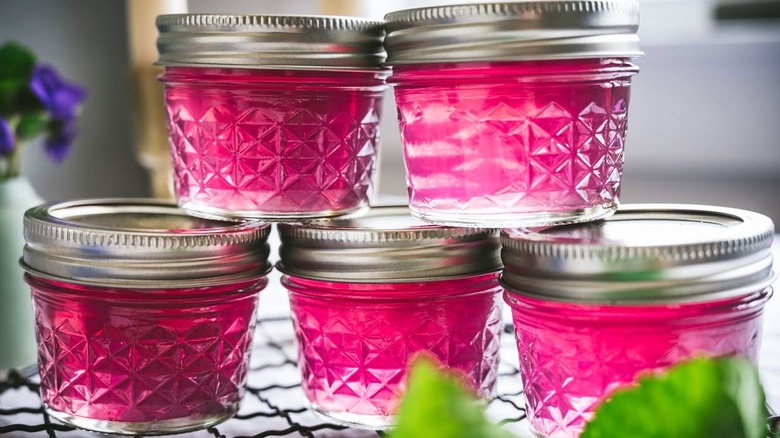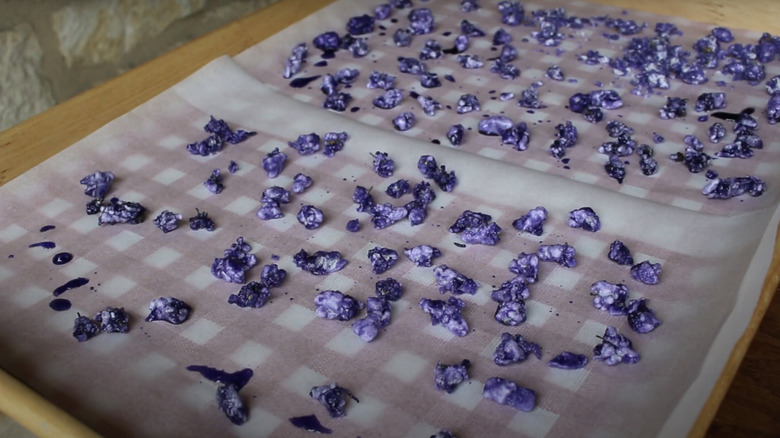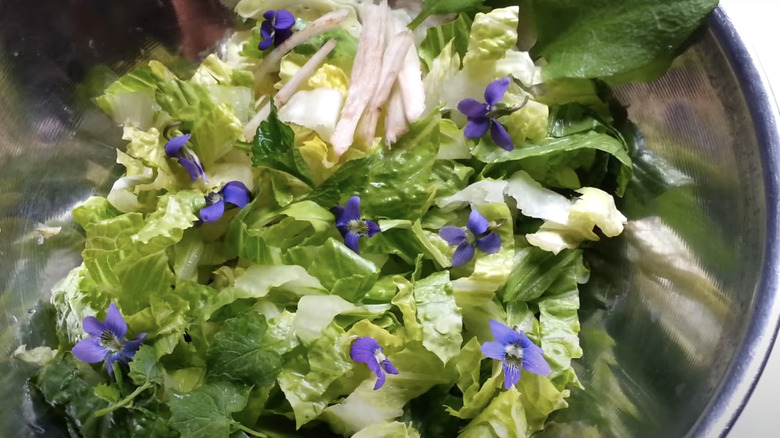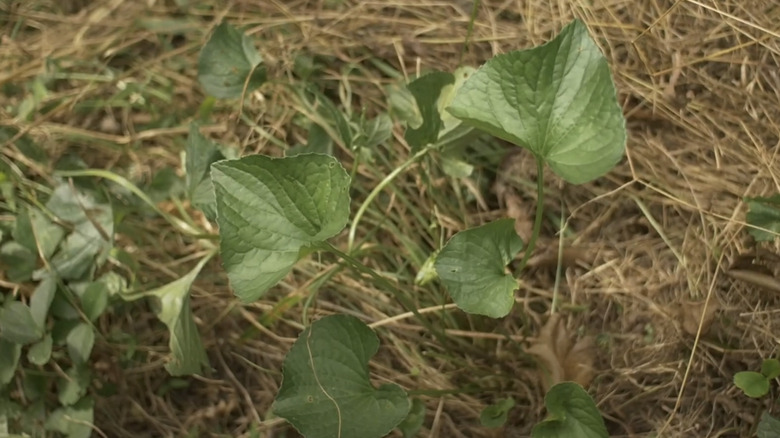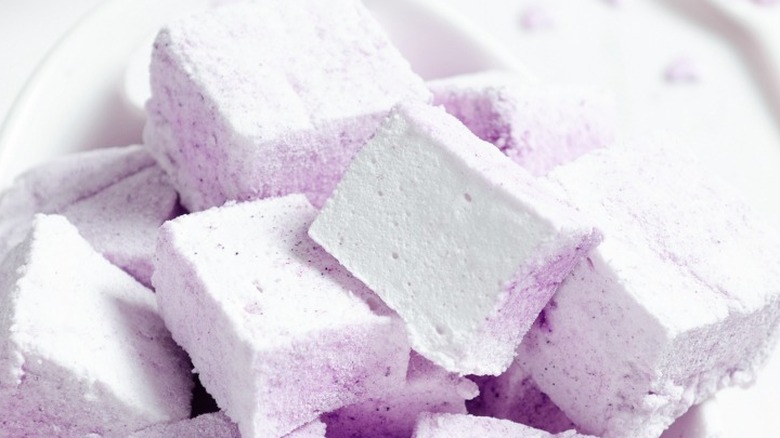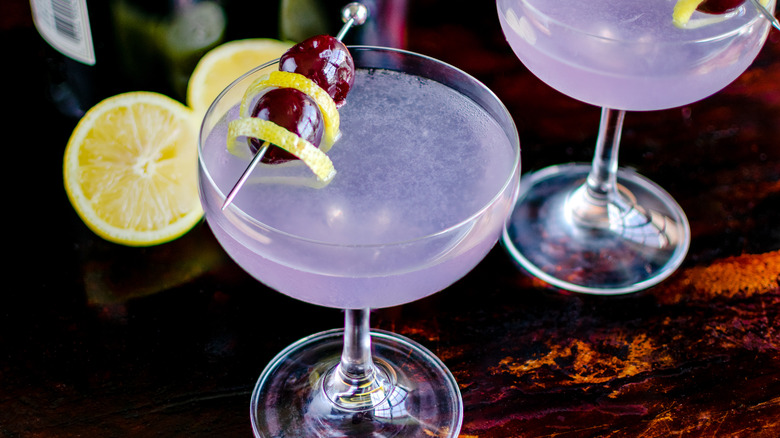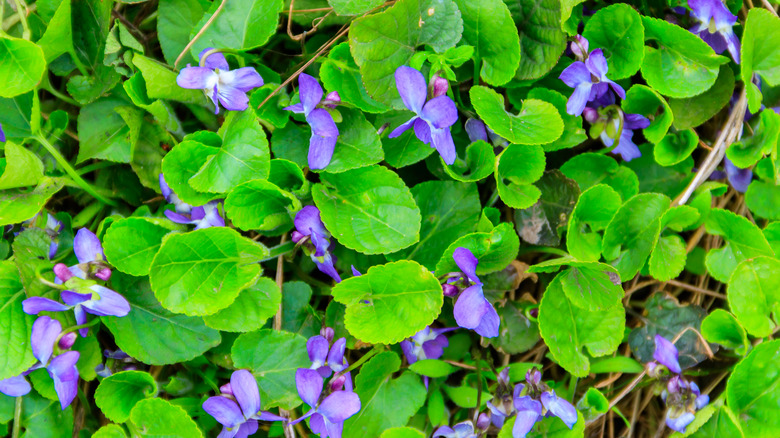The Ultimate Guide To Using Violets In The Kitchen
Violets are humble but wonderful little flowers. Blooming low to the ground in springtime, they're as easy to overlook in the wild as their distinctive flavor is in the kitchen. But these exquisitely colorful blossoms can bring a unique aroma to dishes, both sweet and savory, and they can be used in a surprising number of ways.
The scent of violets is best known as a fragrance used in perfumes, and the flowers themselves have long been used to symbolize lesbian love thanks to the famous poet Sappho of Lesbos, whose writings from almost two and a half millennia ago still resonate with readers to this day. With their delicate and alluring fragrance, it's scarce wonder poets like Sappho have mentioned violets so fondly in verse and song. With a little care, the decadent taste of these vibrant flowers can make a perfect addition to any romantic picnic or candlelit dinner.
In the kitchen, violets can find plenty of culinary uses and, like other edible flowers, they can make attractive garnishes for both food and drinks. While violets aren't commonly used in most modern Western food, they're a traditional part of French cuisine, particularly around the southern city of Toulouse. Here, violets are made into a variety of luxurious food items, including candies, teas, preserves, and, most commonly, syrups. For times when fresh flowers aren't available, the flavor of violets can also be added to foods by using violet essence, which can be bought online.
Types of edible violet
Violets aren't a single type of flower, but a whole variety of them. There are over a hundred species of violet growing in the world, and all of them are edible — although, as the University of Minnesota cautions, some are more palatable than others. Additionally, be certain never to confuse these with the African violet, which is a totally different plant and is not edible.
The type most often used in cuisine is the sweet violet (Viola odorata). This is the variety celebrated in the South of France. Beautifully aromatic, these flowers go well in sweet dishes. They're native to Europe, but have also been introduced to North America, where they can be found growing wild. The Americas have violets of their own, though, and the blue violet (Viola sororia) is one of the most common. These have larger leaves and their flowers have a similar flavor, although this can vary. Wild blue violets can have anything from a sweet fragrance to a mild pea-like flavor that can taste good in salads.
A third common type of violet is the wild pansy (Viola tricolor), which usually has a more savory flavor. These sometimes carry a warning that they contain saponins, a type of compound that can be toxic in large amounts. However, in moderate amounts, studies have found that saponins have a few health benefits, including reducing cholesterol and lowering blood glucose response. Garden pansies are also perfectly good to eat, and are popularly added to salads.
Violet flavour pairings
The characteristic sweet scent of violets comes from compounds called ionones. This is a class of molecules that human noses are particularly sensitive to — a little goes a long way! What's more, the same group of molecules is responsible for the distinctive fragrance of roses. This shared fragrance is why roses and violets have a long association, and means that the two both smell and taste good together. Any recipe that usually uses rosewater would probably taste great with violet essence instead.
Ionones and their related compounds contribute to the flavors of a variety of other things commonly used in foods, and all of these will pair very nicely with the flavor of violets. In particular, for more savory dishes, carrots, asparagus, and chicken will taste good with violets, but the best pairings can be found in sweet dishes. Violets will complement the taste of roasted almond and mango, as well as going particularly well with berries like raspberry, blackberry, and blueberry.
As an aside, ionones are chemically quite similar to vitamin A, which both the flowers and leaves of violets are rich in. Vitamin A is essential for healthy eyes, which is why eating carrots is famously good for your eyesight – they're also full of compounds related to vitamin A. It's no coincidence that violets and carrots taste great together.
Violet syrup
Fragrant violet syrup is one of the best culinary uses for violets. It can be mixed with soda water for a flavorsome drink, or used as an ingredient to create other dishes. One particularly good option to quench your thirst in the summer is to make violet lemonade. This can be made with fresh flowers by infusing them in some hot water, first making violet tea, but a bottle of syrup gives you a handy shortcut. Simply press the juice from some lemons and make your lemonade as usual, but add a dash of violet syrup for an extra flourish. The acidic lemon juice will also make the color change slightly.
Violet syrup can be easily bought in France, or ordered online from French retailers, but it's also quite simple to make it yourself if you have a good supply of fresh flowers. First, gather as many flowers as you can, removing all the green parts. These are edible, but too much of them will spoil the flavor. Place your violets into a glass or steel bowl, and for every cup of violets, pour over one cup of boiling water, then leave it for about a day to infuse. When finished, the whole mixture should be bright purple. Then, simply strain out the flowers, add a cup of sugar for every cup of violets used, and heat gently, stirring until all the sugar has dissolved. This strikingly colorful syrup should keep well in the refrigerator for a few months.
Violet ice cream
Another French specialty, violet ice cream can be found everywhere, from small towns on the Côte d'Azur to the streets of Paris in midsummer. Historically, though, violet ice cream (along with other floral flavors) has been a well-known treat all across 19th century Europe, when it was popular in Victorian England and a favorite of Empress Elizabeth of Austria.
In modern times, violet ice cream is harder to come by. A good option for those who want to enjoy it at home is to try making it themselves. Homemade ice cream is easier to make than you might expect, and there are several ways to prepare it in your own kitchen without needing an ice cream machine. The easiest way to make your own violet ice cream is to add some violet syrup to your mixture of cream and sugar (and possibly egg yolks if you prefer to make something more like gelato). You shouldn't need to use too much syrup, but a little extra will give a nice purple color to your finished dish.
Violet jelly
Just like fruit, violets can also be made into jelly. Fragrant and vibrantly colored, it can make for a wonderfully aromatic breakfast, going very nicely on toast, buttered scones, or warm croissants. Making violet jelly isn't too different from making violet syrup, with the one major addition of pectin. Found naturally in fruit, pectin is a type of sugar acid used as a gelling agent. It's essential to making jam and jelly at home, but flowers like violets don't contain any, so you'll need to add your own. It's easily bought from many supermarkets and cooking suppliers. To give your jelly a pleasant sharpness, you should also add some lemon juice to the mixture, which will turn the jelly a bright mauve color.
Homemade jelly isn't too difficult to make. Just keep a close eye on the pan while it boils to make sure it doesn't start to bubble over. You can start by boiling the flowers and then straining them out before adding your pectin to produce a nice, smooth, and clear jelly, or you can opt to leave the flowers in for the finished product. If you prefer jelly with a slightly chunkier texture, the violet flowers will give you something with a very similar texture to a good rose petal jam.
Candied violets
Violet cream chocolates are a traditional sweet treat from England, dating back to Victorian times, and the classic version has each one topped with a single candied violet flower. The candied flowers themselves have a variety of uses in the kitchen, and a popular choice is to use them to decorate cakes or pastry dishes. Using freshly picked flowers, candied violets may take a little practice to make at home, but they'll certainly be worth the effort.
Also known as crystallized violets, these little candied flowers just need some egg white and some powdered confectioners sugar to prepare. Simply beat the egg white until slightly frothy, and then give the flowers a good coating of it. Then give the flowers a liberal coating of sifted sugar and leave them somewhere to dry. Alternatively, for vegans or anyone with allergies, an egg-free version can also be made by using some simple sugar syrup instead. Candied violets are a flavorsome little ingredient and a colorful way to garnish a dessert. Try using them to decorate a blueberry cheesecake, or sprinkle a few on top of some raspberry sorbet as a garnish!
Violet scones and cakes
For anyone who enjoys baking at home, violets and their distinctive flavor can really elevate things like a light, fluffy cake or a batch of buttery scones. Fruit scones, made with fresh berries, can already be a delightful light bite for anyone with a sweet tooth, and violet and blackberry can be a winning combination for a batch of homemade scones. The simplest method is to simply mix a handful of fresh violets into the dough while you're adding the berries — but if fresh flowers aren't available, a couple of drops of violet essence would also work nicely.
The flavor pairing of violet and blackberries or blueberries is a match made in heaven, and this combination can also make for some absolutely heavenly cakes. The flowers and berries can either be mixed into the batter, like with blueberry muffins, or they can be used to decorate the frosting instead. Violet syrup can also be used to make cake frosting, and for an indulgent treat, it can combine nicely with mascarpone cheese for a creamy cake topping.
Violet salad
Dessert dishes aren't the only thing violets can be used for. The fragrant flowers are perfectly good to eat raw, directly from the plant. A handful of freshly picked flowers can make for a colorful addition to a salad with fresh greens like arugula or baby spinach leaves. The best choices are light, zesty flavors. Sprouts and microgreens can be a good option. Try to avoid any leaves with a stronger, more bitter taste, as these can overpower the more delicate taste of the violets.
The leaves of violet plants are also edible, and these can also go very nicely in a fresh leafy salad. They have a light, pea-like flavor, and mix well with other milder salad greens. As salad leaves, American blue violets are the best choice, as they tend to have larger leaves than European sweet violets. The flavor of violet leaves and flowers can be nicely complemented by the deep flavors of a good honey mustard dressing, with a little tang from a dash of lemon juice.
Alternatively, violet flowers can be used to prepare a vinaigrette to dress a salad with. This is made by infusing vinegar with violet flowers, blending the sweetness of the violet flavor with the sharpness of the vinegar. This can be used to make your violet salad extra fragrant, or it can be used just as well to give a sweet aroma to any other salad. Try drizzling a little over some grated carrots!
Violet leaves
With their mild flavor, violet leaves can make a nice addition to a variety of dishes. With their characteristic heart shape, they can give a romantic twist to a light picnic salad, but they don't need to be eaten raw. Violet leaves can be used in much the same way as any other leafy green, cooked or otherwise. They can taste great steamed or sautéed, and can be served with a little butter and some cracked pepper as a light-tasting side dish. Another good option is to add a handful to a soup.
Violet leaves are best picked early in the season, while they're still a lighter green color. This is when they're most tender. Older leaves, while a little tougher, can still be just as good in the kitchen, though. Turning a darker green as they age, these can be lightly blanched to soften them up a bit before use.
Violet mustard
You may have heard of violet mustard, but it's easy to get confused here. A traditional French condiment is known as Moutarde Violette de Brive, commonly known in English, simply, as violet mustard. However, despite the name and color, this mustard is not actually made with violets. Traditionally, it's made with grape mush leftover from winemaking. At home, it can be prepared with a little red wine and/or ruby port, complementing the sharp flavor of the mustard with the tang of grapes.
However, mustard infused with actual violet flowers also exists in France. Somewhat rarer, it's known simply as moutarde à la violette, and it's a more fragrant version of regular French mustard. This can be quite easily made at home by adding a couple of drops of violet essence to some good-quality French mustard, and it goes well with white meats like pork or poultry like chicken or duck. Additionally, it can be used to prepare a fragrant white sauce to enjoy with some grilled fish.
Violet marshmallows
Anyone who read Roald Dahl books as a child might remember a line in "Charlie and the Chocolate Factory" where Grandpa Joe mentions how Willy Wonka can make marshmallows that taste of violets. This particular candy, though, unlike many of the others from Wonka's factory, is not actually fictional. Soft and pillowy homemade marshmallows aren't complicated to make, though you should be prepared for the process to be a little messy until you've had some practice. If you're making them yourself, though, you're free to add any flavorings and colors you like, and a little violet syrup can give you a batch of soft, chewy marshmallows that really do taste of violets.
Dahl's inspiration for the line in his book may have been a fondness for actual violet-flavored candies, which have been made since the 20th century and can still be found on sale in some places. In the UK, Swizzels makes a fragrant violet-flavored candy called Parma Violets. They have a similar texture to Pez candies, and while they're not one of the most popular items on the shelf, they're a nostalgic favorite among older Brits. The U.S. also has an old kind of violet candy called Choward's Violet Mints, which have been manufactured in New York for decades.
Violet cocktails
There are a few types of liqueur made with violets, and they all have a strikingly rich purple color. The three that you're most likely to encounter are Crème de Violette, Crème Yvette, and Parfait d'Amour, which all have different flavor profiles. The latter two have a few other ingredients blended in, with Crème Yvette also containing summer fruits like raspberry and blackberry, and Parfait d'Amour having the additional flavorings of orange and vanilla. Crème de violette has the purest violet flavor, though it sometimes has a brandy base, giving it a hint of fruitiness.
While violet liqueurs are traditionally served as an aperitif or sometimes mixed with vermouth, they can also be used to make colorful cocktails. For mixing drinks, crème de violette is the best option. The floral violet flavor blends very well with the herbal flavors of a good gin or sharper fruity notes like lemon or cherry. This makes a violet gin martini a nice, simple option, mixed with a nice top-shelf gin and some white vermouth. With its bright, fruity flavors, Hendrick's gin is a particularly good choice here. Alternatively, you could try adding a dash of violet liqueur to a fruit-based cocktail like a lemon drop or maybe a lemon margarita. For something with a little more kick, violet-infused gin can also sometimes be bought, or you could try infusing your own by stuffing a gin bottle with fresh violet flowers.
Hunting wild violets
Violets aren't the kind of thing you're usually likely to find on sale, even at the best farmer's market, so for anyone who wants to try using them in the kitchen, the two most likely options are to either grow your own or hunt for them in the wild. Violets are sometimes sold as garden flowers, and seeds can be bought from suppliers, but in the right conditions, wild violets can grow prolifically. For anyone who likes to go out foraging, they can be a great wild food to look for in the springtime.
If you choose to go flower picking, be certain to consult a guidebook to make sure you can identify them correctly. As a beginner, it's best to go hunting while they're in bloom. Sweet violets grow abundantly in Europe, usually around fields and wooded areas, though they'll happily grow across a lawn if they're able to. They've been naturalized in the U.S., and they're even considered an invasive species in North Carolina, so gathering wild plants for food there is actually beneficial to the environment.
Violets have grown in the Americas since long before Europeans arrived, though. The common blue violet grows all across the central to eastern areas of North America, flourishing as far south as northeast Mexico, often found around woodlands, meadows, and prairies. Violets have long been harvested by the Ojibwe people, who know them by the name waawiye-bagag and gather them both for food and as traditional medicine.
